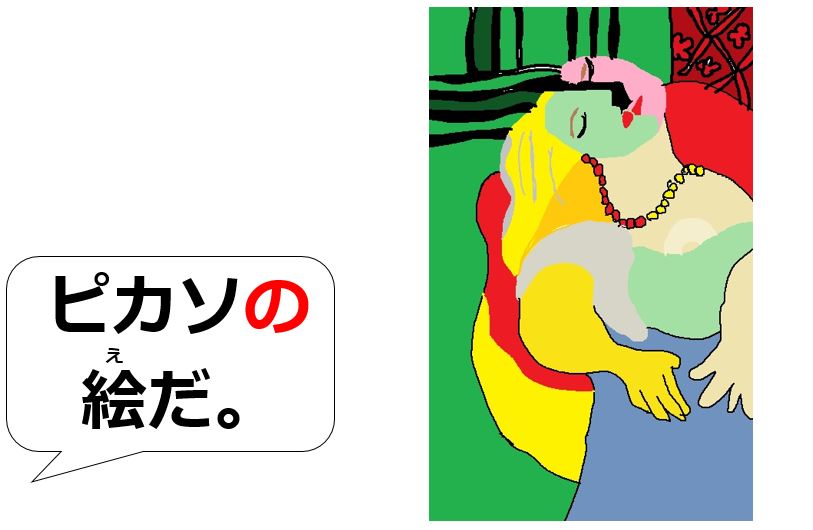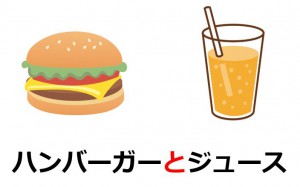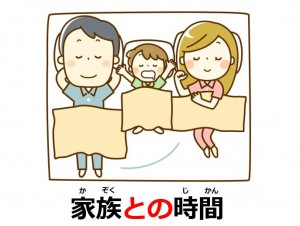In the first entry: Japanese Nouns: State-of-Being, we briefly mentioned the particle の with the sentence pattern: Noun の Noun. As you may have notice already, this is a very useful, powerful particle. In this lesson, you will master all of its functions.
Explanation for How the Particle の Works
Although we have picked up two major roles in the title, they can be further subdivided. This is actually very simple because the form remains the same as “Noun の Noun” and there is a common rule: the first noun modifies the second noun. Let’s go over each function.
Five Functions of the Particle の
Possessor: Noun A Possesses Noun B
| 私のパソコン(だ / です)。 [It] is my PC. |
| 先生の本(だ / です)。 [It] is the teacher’s book. |
| お父さんの車(だ / です)。 [It] is [my] father’s car. |
This is a very simple function. の can express who the possessor is.
Author (Creator): Noun A Creates Noun B
| ピカソの絵(だ / です)。 [It] is the picture that Picasso painted. |
| ビートルズの歌(だ / です)。 [It] is the song that the Beatles composed. |
| 村上春樹の小説(だ / です)。 [It] is the novel that Haruki Murakami wrote. |
There are many cases in which the author and the possessor of a work are different. の can express who the author is. The important point here is that since there is no difference between the forms of the functions; possessor and author, you need to judge which function の works as based on the context.
ピカソの絵(だ / です)。
This sentence can be interpreted as both “It’s the picture that Picasso painted” and “It’s Picasso’s picture.”
Explanation: Noun A Modifies Noun B
| 私のお父さん(だ / です)。 [He] is my father. |
| 城の絵(だ / です)。 [It] is a picture of a castle. |
| 車の本(だ / です)。 [It] is a book about cars. |
| 木の椅子(だ / です)。 [It] is a chair [made] of wood. |
| 中国人の学生(だ / です)。 [He/She] is a Chinese student (*中国人 is a noun in Japanese). |
This is a little difficult in comparison with others. With this phrase: “my father,” you are not a possessor or a creator of your father, but you would like to EXPLAIN that we’re related. In such situations, you can use の to explain something.
Position: Noun A (Basis) and Noun B (Direction)
| 駅の隣: next to the station |
| 学校の前: front of the school |
| 私の後ろ: behind me |
| 机の上: on the table |
You can express positions by using two nouns with の. The first noun works as a basis and the second one works to show a direction. Here are relevant key words.
Vocabulary
| 上: on, over, above |
| 下: under, below |
| 右: right |
| 左: left |
| 前: front |
| 後ろ: behind |
| 奥: inner part, back part, depths |
| 隣: next |
| 東: east |
| 西: west |
| 南: south |
| 北: north |
Apposition: Noun A Equals Noun B
| 私は社長の田中(だ / です)。 I’m Tanaka, managing director. |
| 友達の小林(だ / です)。 [He/She] is my friend Kobayashi. |
| 首都の東京はすごい(です)。 The capital Tokyo is great. |
In English, you can express apposition like this, “I’ll meet my teacher Mr. Kuroda.” In Japanese, you cannot place two nouns in a row. You have to place the particle の in between them. This is the last function of the particle の.
[adsense]
Advanced Topic
Combination
You have learned several functions so far. Don’t be confused because some of them can appear in a single sentence together. Here are examples.
| 私の | 車の | 本 | (だ / です) |
| Possessor | Explanation | Modified Noun | State-of-being |
| [It] is my book about cars. | |||
| ピカソの | 昔の | 絵 | (だ / です) |
| Author | Explanation | Modified Noun | State-of-being |
| [It] is an old picture that Picasso painted. | |||
| 駅の(隣) | 隣の | レストラン | (だ / です) |
| Position | Explanation | Modified Noun | State-of-being |
| [It] is the restaurant next to the station. | |||
| 社長の | 田中の | 写真 | (だ / です) |
| Apposition | Explanation | Modified Noun | State-of-being |
| [It] is the picture of the managing director Tanaka. | |||
| 私の | ペットの | ハチ | (だ / です)。 |
| Possessor | Apposition | Modified Noun | State-of-being |
| [It] is my pet, Hachi. | |||
Omission
As you know, Japanese allows you to omit various elements. The sentence pattern: Noun の Noun is not an exception. You can omit the second noun if the context clearly tells what or whom you’re referring to.
| ピカソの絵は、田中さんの絵 (だ / です)。 As for the picture that Picasso painted, [it] is Tanaka-san’s picture. |
This can be
| ピカソの絵は、田中さんの(だ / です)。 As for the picture that Picasso painted, [it] is Tanaka-san’s. |
| 赤いリンゴは、私のリンゴ (だ / です)。 As for the red apple, [it] is my apple. |
This can be
| 赤いリンゴは、私の(だ / です)。 As for the red apple, [it] is mine. |
Replacement
In English, you can use the expression: “The red apple is sweet. The green one is not sweet.” Since it’s clear that you’re talking about apples, the second apple is replaced with “one.” Japanese also has a similar concept. When the context clearly tells what or whom you are referring to, の can replace the noun.
| 赤いリンゴは甘い(です)。青いのは甘く(ない / ありません)。 The red apple is sweet. The blue one is not sweet. |
| 甘い食べ物は好き(です)。辛いのは嫌い(です)。 Sweet foods are the ones that I like. Spicy ones are the ones that I dislike. |
Be careful. These are only applicable for things or materials. If you use this to people, you will look very rude. Also, you cannot use this for something physically unavailable. Please check the following.
Wrong Example
My wife is beautiful. Tanaka-san’s one is pretty. |
Japan’s heat is the one that I like. India’s one is the one that I don’t like. |
The reason is that “奥さん: wife” is a person and “暑さ: heat” is not a physical thing.
Exception
Let’s dig into how to show positions. How can we describe where the bank is? When you use the particle の with the function: Position, it will be like this:
| 銀行はホテルの隣(だ / です)。 As for the bank, [it] is next to the hotel. |
Then, what happens if the context clearly tells that we’re discussing the position while treating the hotel as a basis? Here is an exception. We cannot omit or replace base nouns.
- Wrong Examples
銀行は、の隣(だ / です)。銀行は、のの隣(だ / です)。
Summary
- The particle can express:
- Possessor
- Author (Creator)
- Explanation
- Position
- Apposition
- The particle の can be omitted or replaced with a few exceptions.
Now, you have a clearer picture about the particle の, which means you have completed the major Japanese particles. Great job! One thing that you still need to learn about particle is that there are combinations of particle called “Combined Particles.” You may have seen this kind expression: 東京では and 東京でも. That’s what you will learn next.






